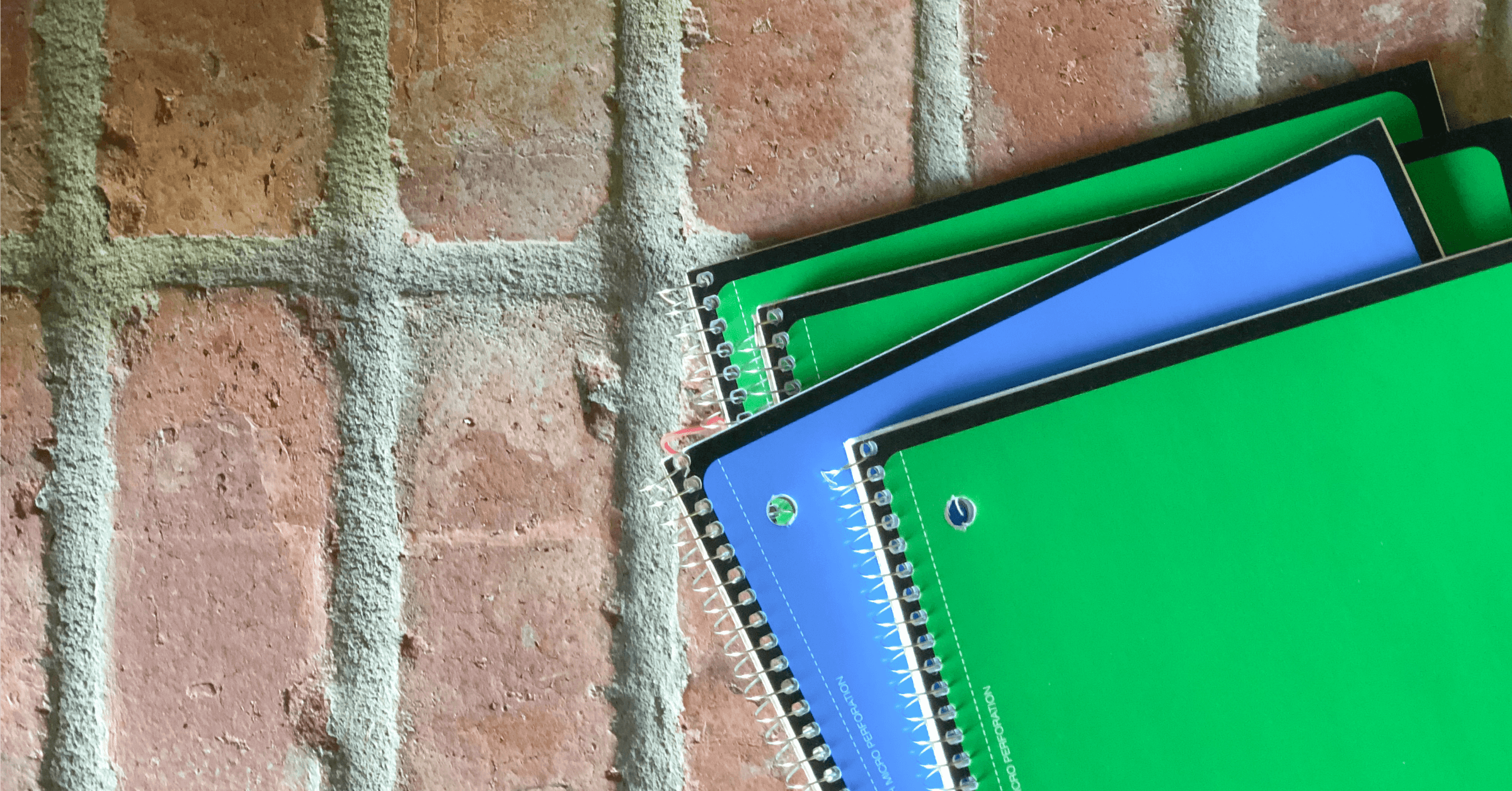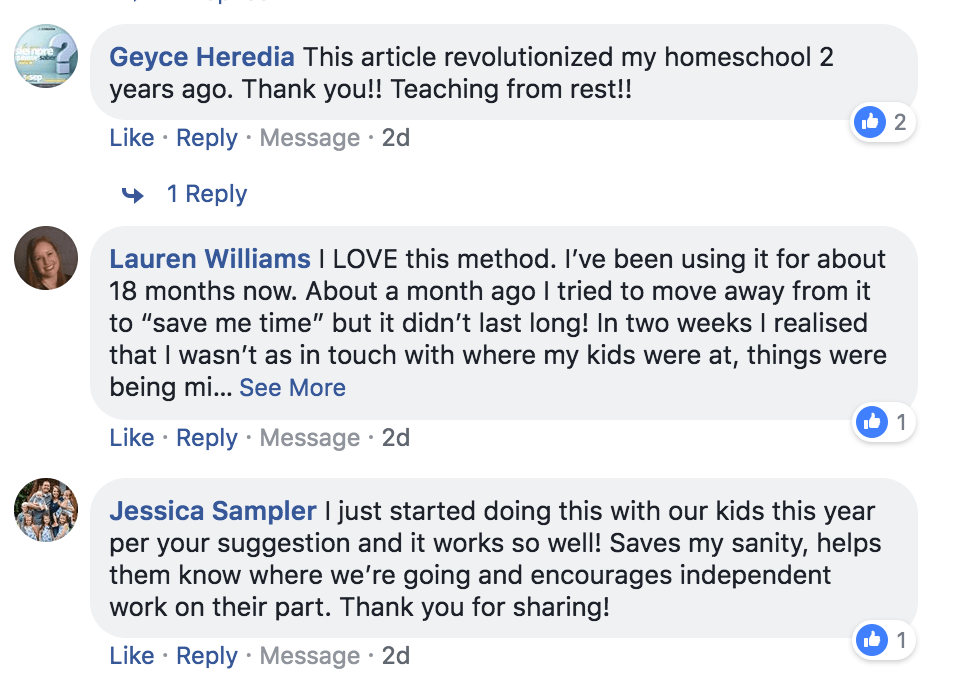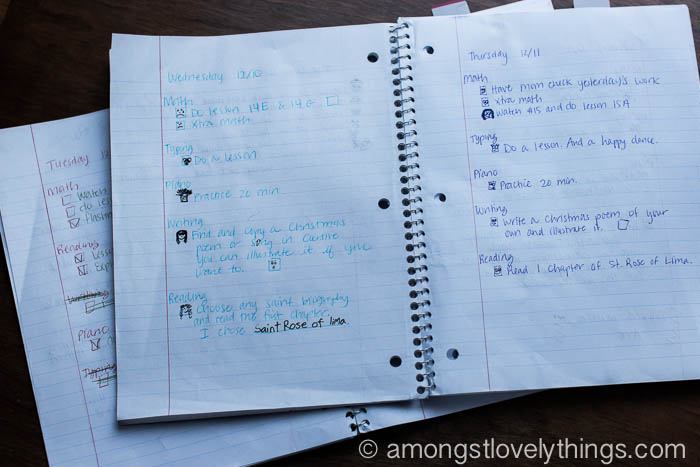Back to the homeschooling grindstone already? Ay yi yi! Doesn’t it feel too soon? I’m not feeling quite as fly-by-the-seat as I often do after a break, though, because I’ve got a new system for keeping track of school assignments, and it’s rocking my world.
I love finding ways to simplify homeschooling, and this method really takes the cake.
I’ll tell you all about it, and then you have every right to say, “Of course, Sarah. Why haven’t you done this all along?” like I said to myself when my friend first showed me how it’s done.
Here’s what happened
Early in December, I was at church, trying to keep my mind focused- it kept drifting off to schoolwork.
In my head, I was finagling how we could possibly combine subjects or weed something out and do less in order to make the school day work.
The days were difficult.
Even though I had pared back and simplified as much as possible, we were still struggling to hit those most important subjects.
Twin toddlers change everything! Add a 2-year-old to the mix and things can get downright disastrous by 10 am, let me tell you. Our school day was feeling it.
After church, I moseyed out to the foyer and gave my friend Sheila a big hug. “How’s it going?” she asked with a smile. Sheila homeschooled her three kids into adulthood and they are just some of the most fantastic kids you’ll ever meet.
She’s not so far removed that she forgets just how hard it was, but she’s got this end-of-the-homeschooling-road wisdom and insight that I just crave to learn from. I absolutely adore her.

She asked that simple question, and I started to fall apart. I can’t do this! There’s too much to get to! Maybe what I’m trying to do here IS actually impossible?
Sheila listened (like she always does), and then she said, “Well, how much of their schoolwork are they doing on their own?” I stopped to think.
She followed up, “And how are you giving them assignments?”
Right. That.
I write them on a white board each morning when I finally get around to it-which is usually in between grabbing a twin off the dining room table and the other one out of the kitchen garbage and washing Posy’s jelly face and changing a diaper and scolding someone for forgetting to shut the door to the basement where a toddler nearly plummeted to his demise.
It’s not a good system.
Sheila came over the next day. She told me I would need a simple 10 cent spiral notebook for each kid, and she would show me what to do.
And she did.
Here’s the groundbreaking system. Are your ready for this?:
Each evening, I write the kids’ assignments down for the next day in their own assignment book.
What? You thought I was going to say something grand and amazing, and you’re a little let down?
I know. I was skeptical at first, too, but I have been floored at the change this simple method has made in our homeschool.
You aren’t alone if you feel like this method sounds too good to be true. But a couple years after sharing this article for the first time, I re-shared it, and this is just a little peek at the responses to it:


See, after I employed this notebook system, we began to consistently get to pretty much everything I assigned for each day by early in the afternoon.
For the first time, I wasn’t having to rack my brain to remember what we were supposed to do when.

Each morning after breakfast, the big kids do their one morning chore, dress and brush their teeth, and then they set to work on their school notebooks.
Instead of feeling pulled between teaching a lesson, caring for toddlers, and setting on soup for dinner, I go about my business with the little ones and the kids go about theirs.
When they have a question or need help with an assignment, they bring their materials to me wherever I am, and I help them on the spot.
If someone else is getting help at the moment, they work on something else in their notebook until I’m free.
I know what you’re thinking (I was thinking the same thing). Something like this, right?:
“I don’t have time to write down assignments each night.”
The truth is, it takes 10-15 minutes. I spent a little time making a master spreadsheet of assignments and how frequently I want each thing tackled, and I use that as a quick reference. It literally takes me ten minutes (max) to look at the spreadsheet and write down the assignments for all three of my school-agers.
If I really can’t carve out ten minutes to do this, I skip sweeping the floor, folding the laundry, or checking Facebook, and I do this instead. It’s worth it.
“Why should I write it out when I could just print out a checklist?”
Because something about the act of writing it out by hand triggers the brain to engage. When I’m writing my 13-year-old’s assignments out, I can tell that I’m giving her too much work when it’s taking me a while to write or the paper is filling up.
It’s so easy to just pop in one more assignment on a spreadsheet on your computer. It’s harder to make the space when you’re writing it out by hand.
Also, writing it out means I’m constantly in touch with where each child is in each of his or her subjects. Instead of just giving an assignment that says “do the next math assignment,” it says “do lesson 14.”
See that box before the math assignment? That’s what this child checks off when she’s done. The box after the assignment means that I need to check it off for her to really be “done” for the day.
If she made a lot of errors, the next day’s assignment will likely be “Watch lesson 14 one more time and make corrections to yesterday’s assignment.”
Writing each assignment out by hand means that I’m staying connected with where she is in every subject.
I can tell if a Latin assignment is taking her longer than usual, or if she’s flying through it in her sleep. In fact, I can more easily keep my finger on the pulse of where each of my kids are in their different subjects.
Some tips that help to make this work:
- Resist the urge to make this more complicated than it needs to be. I use colored pens, but it’s just for fun- not for color coding. You want to remove as many barriers as possible to making this tool do the thing it’s supposed to do. Simple is always better.
- Keep them handy. These spiral notebooks go in a basket on our kitchen counter. The kids take them out, use them, and put them back. They don’t disappear into the school bins or backpacks or any such nonsense. They need to be handy, visible, and always in the same place.
- Use the last 10 pages or so for a booklist. Have you been meaning to print out a booklist form for your kids to record their personal reading on this year? Me too. Why I can’t ever manage to keep enough of those around (or keep track of them when I do) is beyond me, but it’s always the case.
I put a post it flag marking the last ten pages or so of the spiral notebook, and the kids have been instructed to write the book title, author, and # pages of each book they read on their own. At the end of the year, I’ll make transcribing this onto the computer a keyboarding assignment for one of my young typists.
Give it a try!
(Want to see these spiral notebooks in action? I did Here’s a video where I show what they look like in our homeschool.)
So if you’re feeling a bit over-your-head as you hit the books once again, grab a spiral notebook and see if this super-simple system might see you through the dark winter months.
It has been transformative for us- really helping me to teach from rest and restoring my peace in our schooling. The kids love it, too, and have thanked me multiple times for organizing their school day this way.
P.S. Using spiral notebooks was a game-changer for us in simplifying our homeschool. Here are my best tips on how to simplify the homeschool curriculum and how to simplify the homeschool schedule.
Want to listen to this post instead of reading it?





